| Cookridge | |
|---|---|
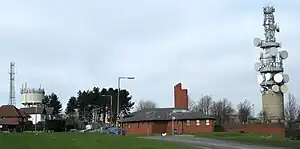 High point on Otley Old Road, showing Tinshill Water Tower (left) Cookridge Fire Station (centre) and the Tinshill BT Tower (right) | |
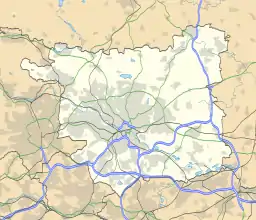 Cookridge  Cookridge Location within West Yorkshire | |
| Metropolitan borough | |
| Metropolitan county | |
| Region | |
| Country | England |
| Sovereign state | United Kingdom |
| Post town | LEEDS |
| Postcode district | LS16 |
| Dialling code | 0113 |
| Police | West Yorkshire |
| Fire | West Yorkshire |
| Ambulance | Yorkshire |
| UK Parliament | |
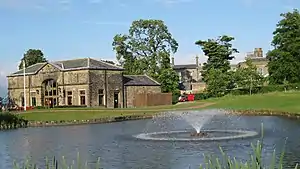


Cookridge is a suburb of north-west Leeds, West Yorkshire, England, north of the Leeds Outer Ring Road. In 1715 Ralph Thoresby described it as a village four miles from Leeds and three from Otley, dating from 1540.[1]
A mixture of suburban and council owned properties on the border with Holt Park and Tinshill, the area sits in both the Adel & Wharfedale ward of Leeds City Council and the Leeds North West parliamentary constituency. Before 2004, the area sat within Cookridge ward, named after the area.
Nearby places include Adel, Holt Park, Tinshill, Horsforth, Bramhope, Moor Grange and Ireland Wood.
Cookridge is one of the highest points in Leeds, with the elevation rising to 198 m (650 ft) above sea level close to the water tower on the eastern edge of the suburb.
Cookridge holds an annual scarecrow festival hosted by the Leeds Modernians.[2]
Geography
Cookridge is located in the foothills of the eastern Pennines. Elevation ranges from 120 m (390 ft) above sea level close to Moseley Beck behind Horsforth railway station to 198 m (650 ft) above sea level by the water tower.[3] Because of its higher elevation it experiences a cooler, windier and wetter climate compared to many other parts of Leeds, and is very exposed to easterly winds. The Beast from the East in February/March 2018 brought heavy snowfall and severe drifting to the area.
Etymology
The name of Cookridge is first attested in the Domesday Book of 1086, as Cucheric. The second element of the name is agreed to come from an Old English word *ric ('narrow strip of land'), attested only in place-names. The origin of the first element is less certain: it could perhaps be from an otherwise unattested personal name, inferred to have been *Cuca, or from a variant of the attested word cwica ('quickset hedge, hedge grown from (hawthorn) cuttings'). Thus the name might once have meant 'Cuca's narrow strip of land' and 'narrow strip of land demarcated by a quickset hedge').[4]
History and buildings
The area had the natural geographic boundaries of the Moseley Beck on the West and South, the Marsh Beck to the North, and the old trackway to the East, running roughly North-South along the line of Spen Lane.[5] A Roman road passing East-West was excavated in 1966 going through Golden Acre Park, south of Marsh Beck. The area later became part of the Kingdom of Elmet, being conquered by the Angles in the 7th century, leading to the Old English name that survives to the present. It was the Danes in the 9th century who named the nearby hill "Tyndr's Hill", now Tinshill.[5]
In the Domesday Book it was listed as the manor of Cucheric, with farmland enough for two ploughs and woodland of 9 square furlongs (36 hectares).[6] In the 12th century, the lands were granted to the monks of Kirkstall Abbey, and in the 13th century the manor became a "vill" or township, part of Cugerig and Adel. The monastery lands were confiscated by Henry VIII and sold off from 1540; this included Cookridge Grange, the site of the present Cookridge Hall.[5]
Cookridge Hall
Early buildings on the Cookridge Hall estate were of wood, thatch, wattle etc., but in the 17th century substantial stone buildings, several which are still in existence, began to be constructed including Cookridge Hall itself. In the early 20th century James Arthur Paul - later of Bramhope Hall - was living with his father, William Paul at Cookridge Hall. James' daughter, Muriel Winifred Middleton née Paul (1904-1979), had married Major Arthur Daryl Middleton in 1933.[7][8][9] A large pond named Paul's Pond remains on the Cookridge Estate, having been named after the grandfather of Muriel Winifred Middleton, William Paul, who had purchased the hall and some of the estate land in 1890.[10]
The builders of Cookridge Hall used "rough rock" or boulders which still are still found in the landscape or quarried in fields known as "quarrels".[5] In the 18th century, Cookridge Hall was substantially remodelled, and many other buildings were improved, with stone replacing thatch.[11] At this time the road through Cookridge became busier with coaches from 1754 and earned money as a turnpike. Milestones and mounting stones from the period still survive. There were also more mills along Moseley Beck, notably the Silk Mill (demolished 1978) which gave its name to modern housing estate.[11] The Hall, which dates from c. 1764, along with its flanking screen walls, gate piers and gates, is a Grade II listed building.[12] It was a home for people with epilepsy from 1955 to 1990 and in 1997 was opened by the Lord Mayor of Leeds as a leisure club with a golf course.[13]
In the 19th century a new road was constructed (now the A660 Otley Road), and the Bramhope Tunnel dug by Moseley farm for a rail line going north from Leeds to Harrogate. A large house called Cookridge Lodge and a tower added. It was demolished in 1970 to make way for an estate, but the gatepost and some outbuildings survive.[11] The Cookridge Estate was bought by Richard Wormald in 1820 and land was sold in portions by his descendant Francis Wormald in the 1920s.[14] In 1926 Cookridge became part of Leeds and the building of Cookridge village began in 1927 with a triangle of houses between Cookridge Lane, Moseley Wood Lane and Green Lane.[11] This was largely under the direction of architect Cecil Crowther and his builder brothers, taking advantage of subsidies from the Housing Acts of 1923-1925. Mavis Lane and Mavis Avenue are named after Cecil Crowther's daughter.[14] Crowther acted as estate agent and produced a 1930 brochure entitled Cookridge - Village of Youth extolling its virtues for newly-weds.[15] This included a map showing 135 plots of an area largely bounded by Cookridge Lane to the east, Moseley Wood Lane to the south, and Cookridge Avenue to the north-west. There were six firms of builders, with different styles.[14] Sporadic building continued, but it was after the Second World War that the majority of the estates were constructed, starting with 1948 Iveson and Ireland Wood; 1952 Tinshill, Silkmill and Woodnook; 1957 Moseley Wood; 1973 Holt Park; 1980 Spring Wood.[11] As the names suggest, these made major encroachments into woodland.
The water-tower was built in 1929 to supply Cookridge village[14] on one of the highest points in Leeds at 198m (650 feet)[16] above sea level. Near the water-tower is Tinshill BT Tower (also known as Cookridge Tower), a prominent landmark.
Sport
Cookridge has three sports clubs: Cookridge Cricket Club,[17] Cookridge Hall Golf Club, and the Leeds Modernians Sports Club [18] which has football, rugby and cricket teams. Bannatyne Group acquired Cookridge Hall in 2019.[19]
Cookridge Hospital
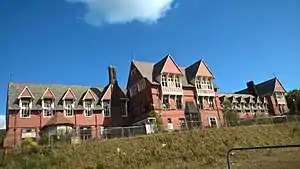
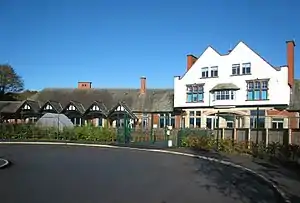
Cookridge Hospital opened in 1869 as a 'Hospital for the Convalescent Poor in Leeds'.[20] It was built in a secluded area by clearing away part of Ireland Wood, with a new road, Hospital Lane from Otley Old Road. The main building and the lodge, designed by Norman Shaw in 1868, are Grade II listed buildings.[21] A further wing was added in 1893, the Edward Jackson Memorial Ward. In 1888 a second set of buildings were opened, the Ida Hospital, named in memory of Ida North, by her father John North. A further similar set of buildings were opened in 1905 named after the benefactor as Robert Arthington Hospital.[22]
The buildings mainly functioned as longer-term convalescent facilities for patients treated in other Leeds hospitals, and were used for the care of wounded servicemen during both World Wars.[23] The whole complex was taken over by the Government in 1939 and part used as a maternity hospital until 1942. In 1952 it became part of the NHS.[24] A 'High Energy Radiation Centre', providing treatment of tumours opened in 1956.[25] From then on it developed into a major regional centre for radiotherapy, with the Ida and Robert Arthington Hospitals becoming home to the Yorkshire Regional Cancer Organization in 1994.[24]
In 2007 it closed and all facilities were transferred to the St James's Oncology Unit (Bexley Wing) of Leeds Teaching Hospitals NHS Trust.[26]
Much of the site was used for housing from 2010, with the listed building being retained for future development.[27] The Robert Arthington Hospital was refurbished and opened in 2015 as the Lighthouse School for pupils with autistic spectrum conditions.[28]
Religion
The Church of England parish church was formerly that of St John the Baptist Church, Adel until Holy Trinity, a brick building on Green Lane, was constructed in 1961. Cookridge Methodist Church is a brick building on the junction of Tinshill Road and Otley Old Road. Grace Community Church meets at Cookridge Village Hall.[29]
 Holy Trinity Church
Holy Trinity Church Cookridge Methodist Church
Cookridge Methodist Church Cookridge Village Hall
Cookridge Village Hall
Education
The main primary schools in Cookridge are Holy Trinity Church of England (Aided) Primary School and Cookridge Primary School[30]
Notable people
- Nick Hodgson, former drummer of the Kaiser Chiefs, was born here.[31]
Location grid
See also
References
- ↑ Ralph Thoresby (1715) Ducatus Leodiensis: or, the topography of the ancient and populous town and parish of Leedes, and parts adjacent in the West Riding of York, pages 157 to 163
- ↑ "Cookridge Scarecrow Festival 2019 - North Leeds Mumbler | Your Local Parenting Community".
- ↑ "Leeds topographic map, elevation, relief". topographic-map.com. Retrieved 15 February 2020.
- ↑ Harry Parkin, Your City's Place-Names: Leeds, English Place-Name Society City-Names Series, 3 (Nottingham: English Place-Name Society, 2017), p. 38.
- 1 2 3 4 Cole, Don (1980). Cookridge: The Story of a Yorkshire Township Part One. Leeds: D&J Thornton. ISBN 0907339-00X.
- ↑ "Place: Cookridge". Open Domesday. Retrieved 7 October 2017.
- ↑ "London Gazette - August 1899". London Gazette. Retrieved 14 August 2022.
...William Paul and [son] James Arthur Paul of Cookridge Hall...
- ↑ "Muriel Winifred Paul - later Middleton". Wynmarsh. Retrieved 14 August 2022.
- ↑ Winchester College Archives (Register) 1884–1934. 1940. Retrieved 18 January 2022.
MIDDLETON, ARTHUR DARYL (D-191Q2), b. 5 Nov., 1892, y. s. of Arthur Middleton, solicitor, of Leeds, and Jessie Marie, d. of Henry Dubs, engineer, Glasgow. R.M.A.; 2 Lt., Northamptonshire Regt., 1911; Capt. 1915; wounded; Instr. 1917–19; retd. as Major 1927; solicitor 1932; with Messrs. Middle- tons, of Leeds. M 20 April 1933, Muriel Winifred, d. of James Arthur Paul, Bramhope Hall, Leeds. Address 2, North Parade, West Park, Leeds 6. Club Naval and Military
- ↑ "Breary March - Paul's Pond". Leeds UK Government. Retrieved 14 August 2022.
- 1 2 3 4 5 Cole, Don (1981). Cookridge: The Story of a Yorkshire Township Part Two. D&J Thornton. ISBN 0907339-034.
- ↑ Historic England. "Cookridge Hall with flanking screen walls, gate piers and gates (1375168)". National Heritage List for England. Retrieved 11 October 2020.
- ↑ Leodis Cookridge Hall Country Club Opening Ceremony
- 1 2 3 4 Cole, Don (2003). An Early 20th c Housing Estate in a Yorkshire Parish. Leeds: Don Cole. ISBN 0-9518016-9-4.
- ↑ C. H. Crowther (1930) Cookridge - Village of Youth reproduced in the booklet by Cole (above)
- ↑ "Streetmap.co.uk- search results for 422905,441255". www.streetmap.co.uk. Archived from the original on 23 October 2012.
- ↑ "Cookridge Cricket Club website". Archived from the original on 19 July 2012.
- ↑ "Leeds Modernians Club website".
- ↑ Wayman, Rebecca (15 January 2019). "Bannatyne Group acquires Yorkshire hall and health club for seven-figure sum". BDaily News. Retrieved 19 February 2021.
- ↑ Steven Burt & Kevin Grady (2002) The Illustrated History of Leeds, 2nd edn (Breedon Books, Derby) ISBN 185983 316 0
- ↑ Brian Godward (2004) The Changing Face of Leeds (Sutton Publishing, Stroud) ISBN 0-7509-3413-1
- ↑ "Cookridge Hospitals, Ida and Robert Arthington". Leodis. Retrieved 20 September 2017.
- ↑ "Cookridge Convalescent Hospital, postcard". Leodis. Retrieved 20 September 2017.
- 1 2 The Story of a Cancer Hospital - Cookridge Hospital 1972-2006. Leeds Teaching Hospitals NHS Trust. 2006. ISBN 978-0-85316-258-2.
- ↑ "Cookridge Hospital, Matron, Miss Elsie Jackson outside the laboratory and Dual-purpose Radiocobalt Unit". Leodis. Retrieved 20 September 2017.
- ↑ Leeds Teaching Hospitals NHS Trust (14 January 2008). "End of an era as final services transfer from Cookridge Hospital to brand new £220M cancer centre". Archived from the original on 27 September 2011. Retrieved 7 April 2008.
- ↑ "Former Leeds hospital site sold for homes". Yorkshire Evening Post. 8 January 2010. Retrieved 20 September 2017.
- ↑ "Specialist Lighthouse School opens after £2.1m investment". Yorkshire Post. 25 November 2015. Retrieved 20 September 2017.
- ↑ Grace Community Church, accessed 8 March 2022
- ↑ "Cookridge primary school website".
- ↑ "Kaiser Chiefs: Leeds and proud". BBC.co.uk. 28 October 2014. Retrieved 14 June 2017.
External links
- "The Ancient Parish of Adel". Genuki. Retrieved 29 October 2007. Cookridge was in this parish
- Historic England. "Cookridge Hospital (1255595)". National Heritage List for England.
- Historic England. "Cookridge Hospital lodge (1255594)". National Heritage List for England.
- Historic England. "Cookridge Hall (1375168)". National Heritage List for England.
- Cookridge Hall website